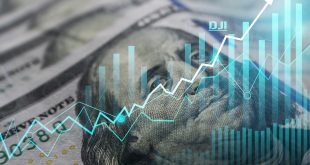The dollar rose to a nearly four-week high against a basket of currencies on Friday, after data showed US consumer prices accelerated in May, suggesting the Federal Reserve may have to keep raising interest rates until September to combat inflation.
In the 12 months to May, the US consumer price index rose 8.6 percent, after rising 8.3 percent in April. Economists had been hoping the annual CPI would peak in April.
The inflation report was released ahead of a second rate hike expected by 50 basis points next Wednesday. The Federal Reserve is expected to raise the interest rate by an additional half a percentage point in July. The bank has raised its overnight interest rate by 75 basis points since March.
The dollar index, which measures the performance of the US currency against six major currencies, rose 0.7 percent to 104.02, the highest level since May 17, and approaching 105.01, the highest level in two decades it had touched in mid-May.
The dollar’s gains were broad-based, but the safe-haven Japanese yen was the only major exception against the greenback.
The yen rose about 0.11 percent against the dollar after the Japanese government and the central bank, in a rare joint statement, expressed concern about the Japanese currency’s slide to its lowest level in two decades. The dollar was last recorded at 134.18 yen.
The dollar rose 0.81 percent against the Swiss franc to 0.9883 francs, after the US Treasury said on Friday that Switzerland continued to exceed thresholds of potential currency manipulation under the 2015 US Trade Act, but declined to be classified as a currency manipulator.
The Australian dollar fell 0.43%, and the British pound fell one percent to 1.2375 US dollars.
In terms of cryptocurrencies, bitcoin fell 2.4 percent to $2,9382.74, while the world’s largest digital currency by market capitalization continues to struggle to overcome a bout of selling pressure that pushed it below $30,000 in recent sessions.
There were 229,000 initial jobless claims in the week ending on 4 June, above the prior week’s reading of 202,000 and expectations for a rise to 210,000. That pushed the four-week average higher to 215,000 from 207,000 a week earlier.
Continued jobless claims in the US in the week ending 28 May remained unchanged versus one week earlier at 1.306M, almost bang in line with market expectations. That meant the insured unemployment rate remained unchanged at 0.9%.
US stocks closed sharply lower on Friday and posted their biggest weekly percentage drop since January, as a bigger-than-expected rise in US consumer price inflation in May heightened investor fears of bigger rate hikes by the Federal Reserve.
Technology and growth stocks, whose valuations depend more on future cash flows, led to the decline.
Stock trading has been dominated by volatility this year, and recent selling has been largely linked to the uncertainty about inflation expectations and interest rates.
According to preliminary data, the Standard & Poor’s 500 indexes fell by 117.05 points, or 2.91 percent, to close at 3,900.77 points, while the Nasdaq Composite Index lost 415.07 points, or 3.53 percent, to 11,339.16 points. The Dow Jones Industrial Average fell 882.47 points, or 2.73 percent, to 3,1395.72 points.
According to the data, Standard & Poor’s lost 5.06 percent during the week, Dow Jones 4.58 percent, and Nasdaq 5.60 percent.
Asia
The Japanese Nikkei index ended a 5-session winning streak on Friday. The Nikkei index fell 1.49% to 27,824.29 points, falling below the main psychological level of 28000, and retreated from the highest level in almost 5 months at 28389.75 points, which was recorded on Thursday, June 9. However, the main index rose 0.23% this week, with gains for the fourth consecutive week.
The broader Topix index fell 1.32% to 1943.09 points, but rose by 0.51% during the week.
The Nasdaq index fell by 2.74% and the Standard & Poor’s 500 index fell by 2.38%. The market is anticipating strong consumer price data for May, which will support the Fed’s tightening of monetary policy even with the risk of economic growth being stifled.
Shares that are expected to grow at a much higher rate than the market’s growth rate, including technology companies, declined as the Topix index of growth companies fell 1.73%.
Chip test equipment maker Advantest fell 4.2%, and chip maker Tokyo Electron fell 3.22%.
Shares of Fast Retail, operator of the Uniqlo clothing chain, and SoftBank Group for technology investments fell 0.93% and 2.01%, respectively.
All 33 industrial sub-indices fell on the Tokyo Stock Exchange, as the machinery sector index lost 2.14%, becoming the worst-performing sector.
Gold and Oil
Gold futures contracts for gold rose to $ 1870 an ounce compared to the last week at 1851
The precious metal fell to its lowest level in the last trading week at $1825 compared to the weekly highs at $1875 an ounce.
Oil fell on Friday as China imposed new lockdown measures to combat COVID-19 and US consumer prices rose more than expected.
Brent crude fell $1.06 to $122.01 a barrel upon settlement. US West Texas Intermediate crude also fell 84 cents to $120.67 a barrel.
The two benchmarks recorded weekly gains of 1.9 percent for Brent and 1.5 percent for US crude.
Prices came under pressure after the US Department of Labor’s Consumer Price Index report. Consumer prices in the United States accelerated in May as gasoline prices hit a record and the cost of services rose further, indicating that the Federal Reserve may continue to raise interest rates to combat inflation.
Peak fuel demand in the US summer pushed gasoline to nearly $5 a gallon.
Parts of Shanghai imposed new restrictions to combat Covid, and the Chinese city announced a round of mass screenings of millions of residents.
China’s imports of crude oil in May increased by almost 12 percent over a year ago.
ECB
On Thursday, the European Central Bank’s (ECB) governing council decided to keep its benchmark deposit rate at -0.50%, as unanimously expected by market participants. The bank also said that it intends to raise interest rates by 25 bps at the July meeting, after having ended its Asset Purchase Programme (APP) on 1 July. The ECB added that a larger than 50 bps rate hike might be appropriate at the September meeting.
The ECB reaffirmed its commitment to bringing Eurozone inflation back to 2.0% and referred to inflation as a challenge for us all.
On basis of its updated assessment, the ECB decided to take further steps in normalising its monetary policy.
If the medium-term inflation outlook persists or deteriorates, a larger rate hike will be appropriate at the September meeting.
In line with the ECB’s commitment to its 2% medium-term target, the pace at which the ECB adjusts its monetary policy will depend on incoming data and how it assesses inflation to develop in the medium term.
Beyond September, based on its current assessment, the ECB anticipates that a gradual but sustained path of further increases in interest rates will be appropriate.
Throughout this process, the ECB will maintain optionality, data-dependence, gradualism and flexibility in the conduct of monetary policy.
 Noor Trends News, Technical Analysis, Educational Tools and Recommendations
Noor Trends News, Technical Analysis, Educational Tools and Recommendations





